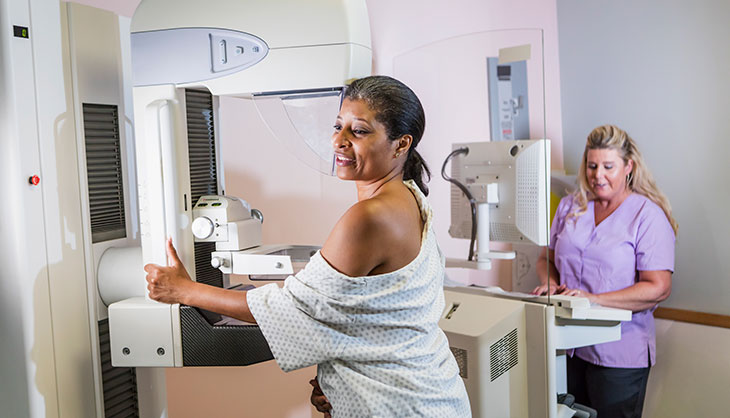
Most of us know someone who has been affected by breast cancer. Our cancer experts at UC Davis Comprehensive Cancer Center share what you should know for early detection, getting screened and more.
What is breast cancer?
Breast cancer is a disease in which cancer cells form in the tissues of the breast. This group of cancer cells can invade surrounding tissues or spread to other areas of the body.
Breast cancer is the most common type of cancer in American women (excluding non-melanoma skin cancer). It's the second-leading cause of cancer deaths in women in the U.S., behind lung cancer.
There are wide disparities in breast cancer death rates. According to the American Cancer Society, as of 2019, breast cancer was the leading cause of cancer death for Black women. Black women are 41% more likely to die from breast cancer than white women, despite being less likely to be diagnosed with it.
See how you can beat the odds by getting screened for lung cancer
What causes breast cancer?
Breast cancer can form when a buildup of cells forms a mass of tissues, called a lump, growth, or tumor. The malignant tumors that develop in the breast can spread when cells break away from the original tumor. The cells can enter the blood vessels or lymph vessels that branch into tissues throughout the body.
Clearing up some myths: Breast cancer is not contagious. It is also not caused by wearing underwire bras, deodorants, mammograms, implants, caffeine, cell phones, or microwaves, according to the National Breast Cancer Foundation, Inc.
Sign up for our Health Highlights e-newsletter
What are breast cancer risk factors?
It's estimated that on average, 1 in 8 women will be diagnosed with breast cancer. It also occurs nearly 100 times more in women than in men. Here are some factors that can increase your risk for breast cancer:
- Being a woman
- Being age 55 or older
- Being Caucasian
- Being overweight or obese
- Having a family history and/or genetic factors, such as an immediate family member who has been diagnosed with breast or ovarian cancer. Your risk increases more if your relative was diagnosed before age 50.
- Past breast cancer diagnosis
- Menstruating at an early age (before age 12) or late menopause (after age 55)
- Having your first child at an older age or having never given birth
- Dense breast tissue
- Treatment with radiation therapy to the breast/chest
- Lack of physical activity and/or poor diet
- Taking hormones such as estrogen and progesterone
- Drinking alcohol
While these can increase your chances, 60-70% of people with breast cancer have no connection to these risk factors, according to the National Breast Cancer Foundation, Inc.
What are the first signs of breast cancer?
When breast cancers are small enough, there may not be any noticeable changes in the breast. As a tumor in the breast grows, it can change how the breast looks or feels. Common changes may include:
- A lump or thickening in or near the breast or in the underarm area
- A change in the size or shape of the breast
- Dimpling or puckering in the skin of the breast
- Nipple turned inward into the breast
- Discharge (fluid) from the nipple, especially if it's bloody
- Scaly, red, or swollen skin on the breast, nipple, or areola (the dark area of the skin at the center of the breast)
Should I conduct a breast self-exam?
Adult women of all ages are encouraged to do a breast self-exam at least once a month. Women often feel a lump in their breast, which prompts them to seek more screening. A self-exam can help you become familiar with your breasts so you can notice any changes.
Learn more about how to conduct a breast self-exam
What are ways my doctor can detect or screen for breast cancer?
UC Davis Comprehensive Cancer Center recommends that women have regular clinical breast exams and screening mammograms. These can help detect breast cancer early, which can allow for early treatment. There are a few ways physicians can find breast cancer.
- Clinical breast exam: A doctor looks for differences in size or shape between your breasts and checks for rashes, dimpling, or other abnormal signs. Your doctor will check your entire breast, underarm, and collarbone area. They will also check the lymph nodes near your breast to see if they are enlarged.
- Mammogram: This is a low dose x-ray of the tissues inside the breast. Mammograms can show a breast lump before it can be felt by a patient or her doctor. They can also show precancerous cells or other conditions. Women should get regular screening mammograms to detect breast cancer early when treatments have the best chance of a cure. Annual screening starting at age 40 saves the most lives from breast cancer. Women younger than 40 who have risk factors for breast cancer should ask their doctor if they should have a mammogram and how often. Women older than age 30, especially Black women, should talk to their doctor about being evaluated for their breast cancer risks. Women who have increased breast cancer risk may need more screening in addition to yearly mammograms.
- Other imaging tests: If a mammogram or clinical breast exam finds an abnormal area, the doctor may order other imaging tests like an ultrasound or MRI (magnetic resonance imaging). These imaging tests provide additional detailed pictures of breast tissue to help your radiology doctor and surgeon determine whether a biopsy in needed.
- Core biopsy: A radiology physician or surgeon may remove a small amount of tissue from an abnormal area of your breast to look for cancer cells.
Learn more about breast cancer screening and diagnosis
Why is it so important to get regular breast exams?
It's important to get regular breast exams because early detection is your best chance to find cancer in the early stages. According to the American Cancer Society, when breast cancer is detected early, and hasn't spread, the 5-year relative survival rate is 99%. Breast cancer that's found early is easier to treat successfully.
Learn more about breast cancer early detection
Find a location near you to get a free mammogram in California
How can I schedule a mammogram at UC Davis Health?
Talk to your doctor about reducing your breast cancer risk factors, and whether you are at an average or increased risk for breast cancer. To schedule a screening mammogram, contact the Breast Imaging Division at 916-734-0655 or make an appointment on MyUCDavisHealth.
The UC Davis Health Breast Imaging Division is an American College of Radiology accredited Breast Imaging Center of Excellence. We offer a full range of breast imaging services with state-of-the-art equipment. We use a variety of biopsy techniques including digital mammography, tomosynthesis, ultrasound, and MRI. Each of our breast imaging exams is read by specialists.
This blog was medically reviewed by Elizabeth Morris, radiologist and chair of the Department of Radiology.




